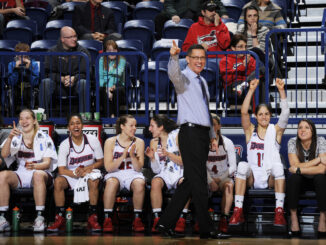Sept. 16, 2021
Staff Editorial
Picture a landscape in which schools located in Provo, Utah, and Cincinnati, Ohio annually compete against one another. Doesn’t that seem like a logistical and financial nightmare?
You don’t have to picture that anymore. It’s becoming a reality.
This past weekend, the Big 12 Conference extended its invitation for Brigham Young, Central Florida, Cincinnati and Houston to join the conference in 2023.
The upside? It boils down to financial gain.
Look at the Big Ten Conference’s 2014 realignment. They poached two schools (Maryland and Rutgers) surrounded by big television markets (Washington and New York) in order to secure more viewership and, accordingly, more money.
It’s a two-way street, however.
In recent memory, Brigham Young has played football as an FBS Independent (they don’t belong to a conference and can schedule anyone they choose), while the school’s other programs compete in the West Coast Conference.
Why float around as a school without an identity when you could join a bigger conference, secure a television deal and get more eyes on your university?
Schools in the Pittsburgh region have shown that conference realignment is a recipe for inevitable disaster.
As members of the Big East Conference, Pittsburgh and West Virginia competed on an annual basis, creating one of NCAA Division I’s fiercest rivalries.
But, when the conference reached its expiration date in 2013, Pittsburgh left for the Atlantic Coast Conference, while West Virginia jumped ship and joined the Big 12 a year earlier.
For Pittsburgh, the results have been lackluster.
The football team has not won more than eight games in a season and is 2-4 in bowl games. The men’s basketball program has made the NCAA Tournament just twice, while also suffering a miserable 0-18 conference record during the 2017-18 season.
The average fan doesn’t care about a game against current conference companions like Georgia Tech or Wake Forest like they would about a game against a bitter Big East rival like Cincinnati or West Virginia. As a result, attendance at both football and basketball games has suffered.
The newest member of the realignment party in Pittsburgh came at Robert Morris, who joined the Horizon League in 2020 after nearly 40 years spent in the Northeast Conference.
Robert Morris, who had a strong recruiting base in the New York region, now has no solid base to work with. In 2020-21, the Colonials’ men’s basketball team played to a 4-15 record.
Even Duquesne tested its waters with realignment, joining the Horizon (then known as the Midwestern Collegiate Conference) for one season in 1992-93. After just one season, the Dukes returned to the Atlantic 10 Conference.
On the surface, conference realignment looks great. Schools have the chance to form an identity, get recognition and reap financial benefits.
However, it’s imperative to be cautious of the particular consequences. If a school is not, they might just end up mired in annual mediocrity.



